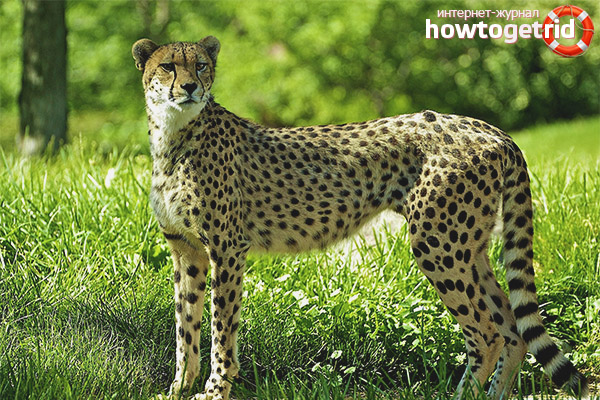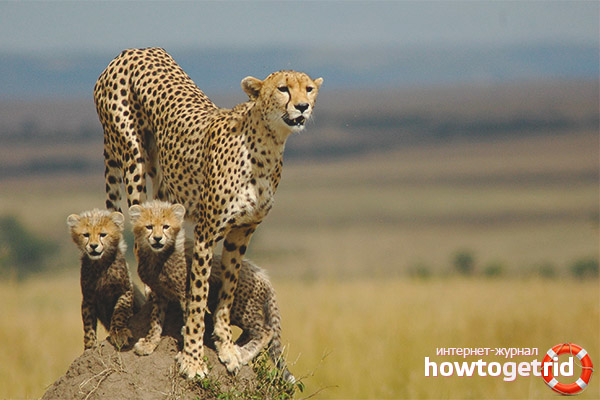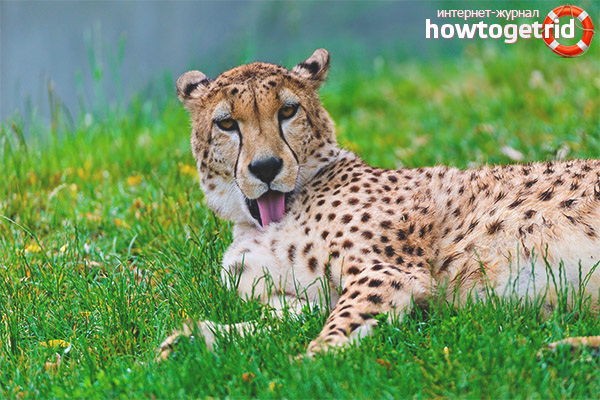The content of the article
A cheetah is a feline mammal predator, a genus of cheetahs. Almost everyone knows that this beast is the fastest in the world. What else is known about these spotted animals?
Description, Appearance
The cheetah is a beautiful beast: a long slender body seems fragile, but the muscles of the animal are well developed. Although the animal belongs to the cat, but the body structure is a bit like a dog. The legs are long, rather thin, but strong, and the claws, as is usually the case with cats, are not pulled into the claws during running - this is conceived by nature so that the beast has good adhesion to the earth's surface, claws play the role of spikes. The head is not very large, the eyes are set high, which is typical for dogs, the rounded ears are small.
The cheetah's body is not very long. But not short either - from 1 meter 20 centimeters to one and a half meters, a height of about 65 centimeters to one meter. The tail length is half the body length - 65-75 centimeters, the cheetah weighs from 45 to 70-75 kilograms.
The fur is short, not very thick, the color of coastal sand, all the skin (except for the belly) is strewn with black specks of various sizes and shapes. Sometimes in the area of the head and the withers, the males may have a kind of mane, consisting of stiff short hair. Young cheetahs under 2.5 months old have this mane, but for many it falls out. And there are lucky ones who have left.
Where dwells
The main habitat is Africa. Moreover, it occupies the entire continent. As you might guess, he lives in deserts and savannas, which have an even relief. Prefers an open area, is not a lover of ambushes.
There are still cheetahs living in Asia. Once upon a time, many Asian regions boasted the presence of these proud animals in their countries. They lived in Egypt, the United Arab Emirates, Afghanistan and other countries. But they were exterminated by man and now live only in Iran.
How does a cheetah hunt?
The cheetah leads a daytime lifestyle and is active only in sunlight, that is, in the afternoon. And he prefers to hunt, too, in the daytime, or rather - either on a cool morning or in the evening sometimes, but always before dusk sets in. After all, he looks for prey visually, and not with the help of smell, so he definitely needs light. At night, the beast hunts quite rarely.
The method used by the cheetah for hunting is rather unusual: while the majority of the cats guard the future victim in ambush, the spotted animal reaches potential prey, pursuing it. First, he looks out for an object for hunting, lying on a high hill or in a bush. Having noticed a potential victim, he tries to crawl to the closest possible distance without unnecessary noise. After quickly jumping up and overtaking an unsuspecting animal. The cheetah runs very fast, interspersed with long, long jumps. When the chase takes place, the cheetah repeatedly changes the path of the run, deceiving and misleading the victim.
This method has to be hunted due to the fact that the open area, where cheetahs live, does not provide conditions in order to find shelter and make an ambush.Therefore, in order to be fed, the beast has to arrange short quick races. Having caught up and overtaking the prey, the predator knocks it off its feet, striking it with a powerful front paw, and then begins to choke. He squeezes the neck of the prey until the animal stops breathing.
Cheetah speed is more than 100 km / h. The maximum officially registered speed is 112 kilometers per hour.
Although the beast has a rather large volume of lungs, such a mad speed exhausts it. If the victim was not caught after 200-400 meters, then the beast no longer pursues it. And if the hunt ended successfully, while the cheetah takes a breath and regains strength, other animals jump to him and, using the weakness of the hunter, steal the deserved prey.
What does a cheetah eat?
Basically, the cheetah preys on ungulates: wildebeests, zebras, gazelles. The hares that appear in the field of view also attract attention and become lunch. And when cheetahs hunt in a group, even large-footed large ostriches are not able to escape from predators.
Cheetahs do not have the habit of eating carrion, even after hiding prey in the bushes and tearing only a piece from it, they no longer return to it. It’s simpler and easier to hunt for new prey. And the food hidden in the bushes remains there, however, not for long - there are enough hunters to eat the abandoned and hidden in the desert. Hyenas, leopards, sometimes even lions appear to be candidates.
Breeding
The mating season begins in different ways, there is no clearly defined period. When the year comes, the males gather in small - 2-5 animals - groups. Usually it includes cheetah brothers who have reached maturity. Such a clan protects the territory with future partners from encroachment of males from the side.
Females reach puberty at 2 years old, sometimes a little later, but estrus starts earlier - at about a year and a half. Another feature of these animals is that ovulation in the female begins only in one case - when the male starts to run after her. And run literally, physically. During mating games, cheetahs arrange long, long races. In all likelihood, this fact serves as the reason that they do not breed in captivity - in zoos there are no conditions for running.
Cheetah’s pregnancy lasts about three months - from 85 to 95 days. Several children are born - up to 6 can be. Cubs are born blind, eyes open only after 10-15 days. The coat of small predators is long, and so that in a colorless area the mother could easily find them, it has a gray-blue color. There are no spots on the skin of babies characteristic of cheetahs - they appear a little later. Kids are decorated with peculiar identification marks: a black-brown mane grows on the head, and the end of the tail is equipped with a dark tassel. Somewhere in the fourth month of life, these signs disappear.
Until three to four months, the mother feeds the offspring with milk, and then the parents slowly add meat to the diet. The mother is engaged in upbringing, the children are next to her for a whole year. The father does not raise offspring, but if something happens to his mother, he replaces her, becoming a good educator and mentor.
But, unfortunately, parental care does not help many cheetahs survive even up to a year. Some children are eaten by stronger predators, and many kittens are trapped by the genetic diseases from which they die.
The reason for these diseases is that in ancient times during the onset of the ice age, most of the animals died, and cheetahs were also close to this. There were several individuals left, while they were relatives. Perhaps this is the cause of the disease.
The difference between cheetahs and leopards
Often people confuse two animals - a cheetah and a leopard. Both of these species belong to the class of mammals, both predators, both are related to feline.Only genera are different: leopards are panthers, and cheetahs are cheetahs. Key differences:
- The body of both animals is slim and flexible. Only the cheetah stretches to one and a half meters, and the leopard boasts 180 centimeters. And the leopard tail will be longer - up to 110 centimeters against the short tail of the cheetah - only 75 cm.
- This important difference can be seen observing the run. The cheetah’s speed is over 100 kilometers per hour, while the leopard is much slower - even at short distances it cannot run faster than 60 km / h.
- Leopard takes prey in his teeth and climbs to feast on a tree. The cheetah has no such habit.
- In a leopard, like in most cats, the claws retract, while in a cheetah, they retract a little - the main part remains outside.
- The cheetah prefers to rest at night, hunting only during the day. The leopard goes hunting in the twilight or night.
- A cheetah can hunt in a pack, and a leopard is a lone hunter.
- The cheetah's face is decorated with a distinctive sign - black stripes go from the eyes in the direction of the mouth. The leopard is deprived of such a sign.
- The specks with which the cheetah skin is decorated are clear, but they do not form or create any patterns. On the skin of a leopard, spots are collected in sockets, and they can also merge with each other and be solid.
- In leopards, children are born with a spotted skin, while small cheetahs acquire spots later.
- The cheetah lives in the savannahs and deserts, preferring the flat landscape. Leopard lives not only in savannahs, but in forests, floodplains and in mountainous areas.
- The leopard has a much wider habitat. The cheetah lives only on the African continent, and in small numbers in Iran, and the geography of the leopard is much larger: in Africa, India, the countries adjoining the Hindustan, in the north and south of China, in Asia, the Far East, etc.
Subspecies
There are five subspecies of cheetahs in total. Four of them inhabit Africa and one in Asia. More than four thousand species live on the African continent, and the Asian cheetah is very few. In total, according to various estimates, from 10 to 60 animals living in natural conditions, mainly in Pakistan and the mountains of Afghanistan. About two dozen live in zoos. The Asian subspecies is not very different from the African one: the legs are shorter, the neck is more powerful and the skin is thicker.
Royal cheetah and other colors
Mutations in genetics lead to a change in the usual colors of cheetahs. So, the royal cheetah has a special color. Longitudinal dark stripes pass through the entire back, large spots merging together become black on the sides. Unusual color have not only royal cheetahs. In nature, there are many other predators, such as:
- Albino cheetahs - they are completely white.
- Absolutely black cheetahs with barely noticeable spots (the so-called melanism).
- Cheetahs of red color with reddish or yellow-brown hair with pale scarlet spots.
In deserts there are also animals with a dull and very faded coat color. Most likely, the point here is disguise and fitness for life under the hot rays of the sun.
Life span
In natural conditions, the cheetah live up to 18-20 years, sometimes live to the mark of 25 years. In captivity, where others have better living conditions and good medicine, they can live much longer.
It happens that the cheetah chases the victim over and over again, but the attempts fail. After a dozen such unsuccessful attempts in a row, the beast may die from a lack of food, because it will completely exhaust its strength.
When the next attack fails, the cheetah immediately stops without wasting power. If the beast runs at maximum speed for at least half a minute, it will fall from the received heat stroke, because while the animal is running, the body generates a lot of heat.
It is interesting! Hunters of Ancient Egypt tamed cheetahs and used instead of helpers during the hunt.
A cheetah can go without food for about a week.
Communicating with each other, they make not cat sounds, and not even dog sounds. Their communication resembles a bird's tweet.
Cheetahs are very well adapted for living in arid areas. So, an adult beast can do without water for several days.
There are many predators in Africa, the weakest of them is our hero, the cheetah. There are many cases when he became a victim of alligators.
Video: Cheetah (Acinonyx jubatus)













Submit